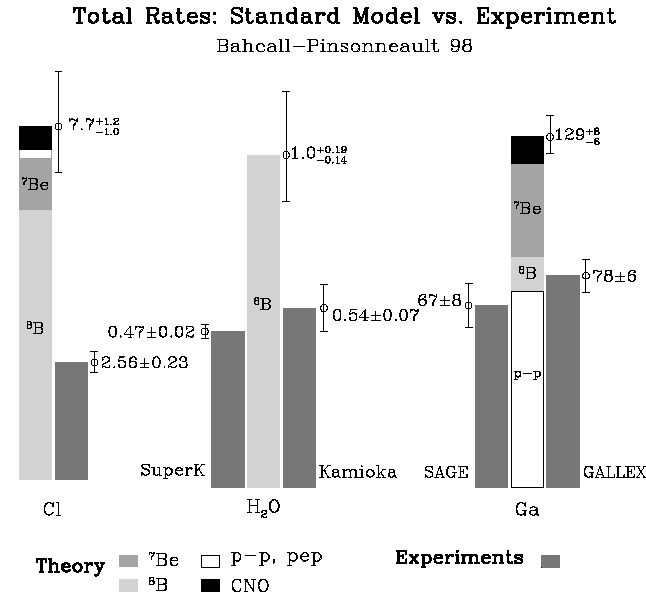Solar Neutrinos
What about those funny neutrino things? What is a
neutrino?
- It's very light (perhaps massless, perhaps
not)
atomic particle.
- lots of them -- >500 million per cubic meter.
- Solar flux: 6x1014 per m2
per sec.
- It can come in a variety of energies.
- It can come in a variety of types ("flavors"):
- electron neutrino
- muon neutrino
- tau neutrino
- It has a very small interaction cross section:

We can calculate the mean
free path of a neutrino inside the Sun to be

Once created, they nearly all immediately escape
from the Sun. If we can see them, we can see into the very center of
the Sun.
How do we detect these neutrinos?
The Chlorine Experiment
- Take a lot (100,000
gallons) of cleaning fluid:

- Bury it 1.5 km
underground (in the Homestake Mine, SD)
- Note the following reaction:

- Argon is a gas; collect the gas, sweep out the
argon.
- Count Argon atoms. (one, two, three... are
we having fun yet?)
This experiment finds 2.6 +/-
0.2 SNUs (solar neutrino units
-- basically 10-36 reactions/atom/day). This is like 1
reaction every two days. But theoretical
models of the Sun predict 7.7 +/- 1.1 SNUs.
We don't see enough
neutrinos! This is the Solar
Neutrino Problem.
What's the solution?
- Experiment is wrong.
Other detectors, using different techniques,
have verified the result.
- We don't understand
the
conditions in the solar interior.
Perhaps the core is a lower temperature? Different
composition? All these changes would lead to new problems with the
solar model.
- We don't understand
neutrinos.
Perhaps neutrinos oscillate between types
(electron, muon, tau). Until very recently detectors only sensitive to
electron neutrinos. If the neutrinos change type, we may be missing
many of them.
Most recent recents from the SuperKamiokande
experiment and the
Sudbury
Neutrino Observatory detect these kinds of neutrino
oscillations.
This also argues that neutrinos have very small, but non-zero, mass.
Here is a good description of neutrinos and neutrino
oscillations from some of the folks involved in Super
Kamiokande.
And information from the Sudbury
Neutrino Observatory, too.

